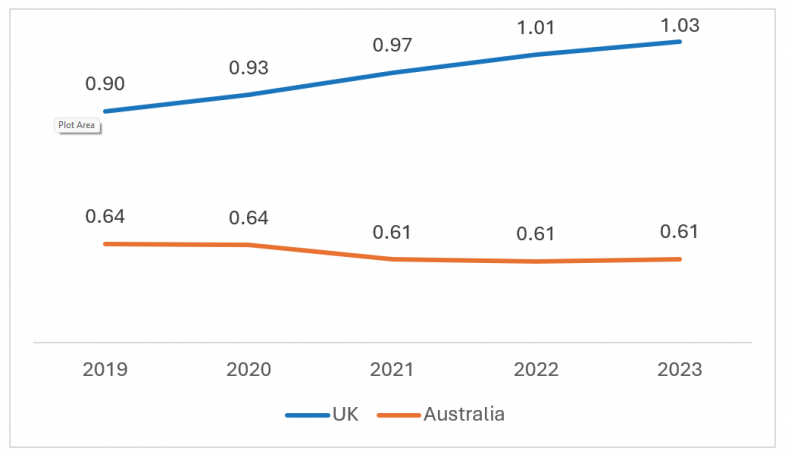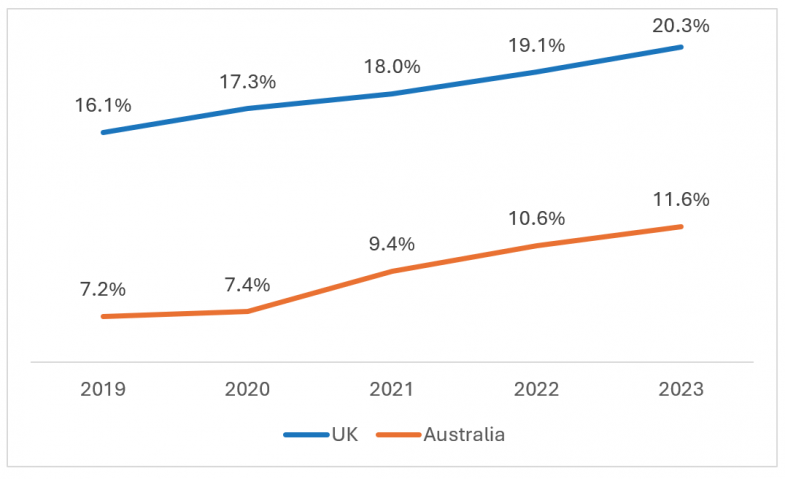Of all the recommendations made in Australia’s landmark Universities Accord, published a year ago today [25 February], perhaps the most eye-catching related to participation.
The Accord team recommended lifting the tertiary attainment rate (Certificate III or above) to 80 per cent by the year 2050, by which time 55 per cent of 25-34-year-olds should have a university degree.
To achieve these targets, nearly two-thirds of enrolment growth will need to come from equity groups: low socio-economic background (low-SES) students, First-Nations Australians, people from regional/rural areas, and those with a disability. But as the Accord implementation process enters its second year, it is worth examining how realistic this really is.
To that end, we can contrast Australia’s national performance on access and equity against recent equity data released by the UK’s Higher Education Statistics Agency (Hesa). It turns out Australia is lagging far behind our northern hemisphere peers.
Advice on equity, diversity and inclusion in higher education
Let’s take low-SES students. Australia measures socio-economic disadvantage based on postcode – so, by definition, 25 per cent of the population is in the lowest quartile postcodes. Yet only 17 per cent of our university student base comes from these postcodes.
In the UK, socio-economic disadvantage is measured by quintiles of “deprivation”. Remarkably, quintile 1 students (the most deprived 20 per cent) are now over-represented in higher education relative to their share of population – they made up 23.6 per cent of undergraduate commencements in 2023 and 20.6 per cent of undergraduate students in total.
To compare Australia’s quartiles data to the UK’s quintiles, I have charted each group versus its share of the population, where a figure of 1.0 means higher education participation matches the share of population. The ratio in the UK has been rising steadily in recent years, while Australia’s ratio has fallen over the same time frame (after peaking in 2017, the last year of the demand-driven funding system).
Ratio of university enrolment of low-SES students to their share of the wider population

An even greater gap exists between the UK and Australia in university participation of students living with a disability. In the UK, 20 per cent of domestic students have a reported disability, compared with just 11.6 per cent in Australia.
Given that both measures are based on self-reporting, it would seem unlikely that the gap is caused by data or reporting discrepancies. Nor is it likely that there are proportionally double the number of people living with a disability in the UK compared with Australia.
The simple explanation for the gap is that UK universities have had far more success attracting and enrolling students with a disability than their Australian peers have. As the graph below shows, there has been solid growth in disability participation rates in both countries over the past five years, but Australia still has a long way to go to catch up.
Percentage of domestic university students with a reported disability

Sources: UK Higher Education Statistics Agency; Australian government, Department of Education
We know, however, that access to university is not the only issue for equity students. In the UK, despite high rates of access, low-SES students rank well below high-SES students in retention, completion, attainment and progression to employment or further study. Completion rates for the least deprived students, for example, consistently run 10 percentage points higher than the rate for the most deprived students.
Retention and completion rates among equity groups in Australia also lag those of non-equity groups. Although the gaps are not as large as those in the UK, there has been no improvement in equity student retention or completion rates in Australia over the past 15 years – except among Indigenous students, who have recorded consistent rises in both ratios over the past decade.
So, what are the implications of this data and the gaps between Australia and the UK?
The UK experience shows that Australia should be able to target higher rates of access among equity group students. However, growing access alone will not be enough to achieve the Accord’s attainment targets. To do that, our higher education system in Australia will need to reverse years of underperformance in the success rates of equity-group students. And that will require investment to provide the supports and services that enable equity students to continue and succeed in their studies.
Yet with Australian universities increasingly cash-strapped and facing bipartisan pressure on international student numbers, it seems unlikely that this funding will come from the institutions themselves. The Accord envisages student funding becoming needs-based, but it is hard to see either side of politics funding that adequately with the federal budget facing structural deficits and major spending commitments in defence, health, disability and aged care.
If the government wants to give the Accord targets – and equity students – a greater chance of success, perhaps it could revisit the restrictions on the international student market and allow universities greater access to it in return for a commitment to use a proportion of the funds on support programmes for domestic equity students.
The sector is already worried about increased regulation. But perhaps this is the only way to meet the Accord’s well-intentioned targets.
Justin Bokor is an independent adviser and former director of EY and Monash University.
Register to continue
Why register?
- Registration is free and only takes a moment
- Once registered, you can read 3 articles a month
- Sign up for our newsletter
Subscribe
Or subscribe for unlimited access to:
- Unlimited access to news, views, insights & reviews
- Digital editions
- Digital access to THE’s university and college rankings analysis
Already registered or a current subscriber?








